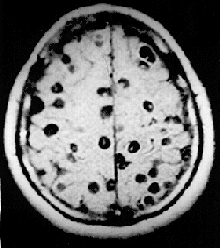Neurocysticercosis

Neurocysticercosis /ˈnjʊəroʊˌsɪstiˌsɜːrˈkoʊsɪs/ is a specific form of the infectious parasitic disease cysticercosis which is caused by infection with Taenia solium, a tapeworm found in pigs. Neurocysticercosis occurs when cysts formed by the infection takes hold within the brain causing neurologic syndromes such as epileptic seizures. It has been called a "hidden epidemic"[1] and "arguably the most common parasitic disease of the human nervous system".[2]
The epidemiology of Taenia solium cysticercosis is solely associated with local cultural practices especially poor sanitation and is highly endemic in Sub-Saharan Africa, Latin America and Asia.[3][4] Infection by Taenia solium cysticercosis, the pork tapeworm larvae in human, spares no ethnic group.[5] Cysticercosis in the United States, which commonly presents in the form of neurocysticercosis, has been classified as a "neglected tropical disease",[6] which commonly affects the poor and homeless, particularly those without access or in the habit of inadequate hand-washing and in the habit of eating with their hands. Neurocysticercosis most commonly involves the cerebral cortex followed by the cerebellum. The pituitary gland is very rarely involved in neurocysticercosis. The cysts may rarely coalesce and form a tree-like pattern which is known as racemose neurocysticercosis, which when involving the pituitary gland may result in multiple pituitary hormone deficiency.[7]
References
- ↑ Zimmer, Carl (15 May 2012). "Hidden Epidemic: Tapeworms Living Inside People's Brains". Discover Magazine.
- ↑ White, A. C. (1997). "Neurocysticercosis: A Major Cause of Neurological Disease Worldwide". Clinical Infectious Diseases. 24 (2): 101–13, quiz 114–5. doi:10.1093/clinids/24.2.101. PMID 9114131.
- ↑ Flisser, Ana; Sarti, Elsa; Lightowlers, Marshall; Schantz, Peter (2003-06-01). "Neurocysticercosis: regional status, epidemiology, impact and control measures in the Americas". Acta Tropica. International Action Planning Workshop on Taenia Solium Cysticercosis/Taeniosis with Special Focus on Eastern and Southern Africa. 87 (1): 43–51. doi:10.1016/S0001-706X(03)00054-8.
- ↑ Mwanjali, Gloria; Kihamia, Charles; Kakoko, Deodatus Vitalis Conatus; Lekule, Faustin; Ngowi, Helena; Johansen, Maria Vang; Thamsborg, Stig Milan; Iii, Arve Lee Willingham (2013-03-14). "Prevalence and Risk Factors Associated with Human Taenia Solium Infections in Mbozi District, Mbeya Region, Tanzania". PLOS Neglected Tropical Diseases. 7 (3): e2102. doi:10.1371/journal.pntd.0002102. ISSN 1935-2735. PMC 3597471. PMID 23516650.
- ↑ Schantz, Peter M.; Moore, Anne C.; Muñoz, José L.; Hartman, Barry J.; Schaefer, John A.; Aron, Alan M.; Persaud, Deborah; Sarti, Elsa; Wilson, Marianna (1992-09-03). "Neurocysticercosis in an Orthodox Jewish Community in New York City". New England Journal of Medicine. 327 (10): 692–695. doi:10.1056/NEJM199209033271004. ISSN 0028-4793. PMID 1495521.
- ↑ Hotez, Peter J. (2014). "Neglected Parasitic Infections and Poverty in the United States". PLoS Neglected Tropical Diseases. 8 (9): e3012. doi:10.1371/journal.pntd.0003012. PMC 4154650. PMID 25188455.
- ↑ Dutta, Deep; Kumar, Mano; Ghosh, Sujoy; Mukhopadhyay, Satinath; Chowdhury, Subhankar (2013). "Pituitary hormone deficiency due to racemose neurocysticercosis". The Lancet Diabetes & Endocrinology. 1 (2): e13. doi:10.1016/S2213-8587(13)70026-3. PMID 24622323.
External links
- Clinical Diagnosis of Neurocysticercosis, PDF file